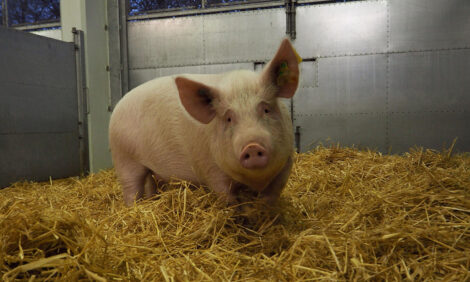



Better Molecular Insights in the Pathogenesis of PRRSV Infections and Immune Response Show the Way for More Efficient PRRSV Vaccines
The numerous recent breakthroughs in the pathogenesis of porcine reproductive and respiratory syndrome virus (PRRSV) infections and the immune response/modulation have brought light at the end of the tunnel for vaccine developers, according to H.J. Nauwynck and co-authors at Ghent University in Belgium, speaking at the International Symposium on Emerging and Re-Emerging Diseases in Pigs in 2011.Porcine reproductive and respiratory syndrome virus (PRRSV) is a major porcine pathogen, causing huge losses in swine industry since the end of the 1908s. American and European type attenuated vaccines were quickly introduced in the 1990s, with good results. Inactivated vaccines were also registered but were only able to boost an existing immunity.
At the beginning of the 1990s, the isolates in Europe and North America were genetically homogeneous. However, over the next decade, the viruses started to diverge. This led to the appearance of PRRSV strains that were more difficult to control by existing vaccines and that were more virulent. At present, it is extremely difficult to develop safe and efficacious vaccines with a broad activity. The traditional approaches of trial and error/success are no longer very successful. That is where the quest for new generation PRRSV vaccines starts. A veterinary fundamental research–orientated approach is the only one that can result in better vaccines for controlling PRRS in the long term. Better insights in the pathogenesis and the immune response will show the way.
Hallmarks of the pathogenesis of PRRSV infections are the specific tropism of the virus for differentiated macrophages (lungs, lymphoid tissues and placenta) and persistence due to immune–evasive and immune–modulating properties of the virus. The specific tropism can be explained by the beautiful interplay between viral and macrophage molecules.
It all starts with an interaction of the GP5/M complex in the viral envelope with heparan sulphate moieties on cellular glycoproteins anchored in the plasma membrane. These weak virus–sugar interactions are allowing the virus to glide through the roof of foliage of the ‘sugar forest’ till it finds its real receptor, sialoadhesin. Sialic acids on the GP5/M complex are binding to this lectin. Binding of the virus to sialoadhesin activates a clathrin–mediated internalisation. The viruses end up in early endosomes where a pH drop is necessary for the disassembly together with CD163 and proteases (cathepsin E and/or a serine protease). After release of the nucleocapsid in the cytoplasm, translation and transcription, assembly and egress follow.
The immune response is not at all efficient in controlling virus replication. The virus developed in evolution a certain number of anti–immune tricks to escape from elimination. This is already clear at the very early stages of infection. Extremely low levels of interferon alpha are produced. The humoral immunity starts like with other viruses. Antibodies against the nucleocapsid can be found at one week of infection. In this perspective, nothing goes wrong. High titres are reached and a normal isotype switch is detected. However, antibodies against envelope proteins, under which neutralising antibodies, are raised at later stages.
Glycosylation and decoy activities are forwarded as the main reasons for the late appearance of neutralising antibodies. Once they appear, neutralising antibodies are very helpful in eliminating cell–free virus. However, the antibodies cannot eliminate infected cells because viral envelope glycoproteins are not expressed on the plasma membrane. They are retained in the endoplasmic reticulum and as a consequence the antibody–dependent cell lysis by complement and phagocytes is not occurring.
By pepscan analysis of the envelope glycoproteins of European PRRSV strains, it was demonstrated that porcine anti-PRRSV antisera recognise 21 antigenic regions and that pig differences exist in the recognition pattern. After purifying peptide–specific porcine antibodies, functional analyses were performed. Porcine antibodies that recognise the peptide aa 57-68 of GP4 are strongly neutralising PRRSV, which was interesting in the direction of vaccine development. However, due to a huge variation in this region cross-neutralisation did not occur, burying the vaccine dreams. In addition, two neutralising antigenic regions were found in GP2, two others in GP3.
One neutralising antigenic region in GP3 is very conserved and neutralising antibodies against this region were found in most infected pigs. This is an interesting region for vaccine development. No neutralising antigenic regions were found in M and GP5. The cell–mediated immunity is delayed in comparison with other viral infections. Cytotoxic T–lymphocytes are not eliminating PRRSV–infected macrophages and NK cells are suppressed in their cytotoxic function. However, an as yet undefined sub–population of leukocytes is able efficiently to lyse PRRSV–infected macrophages.
* "The ‘one–vaccine–fits–all’ vision of some people should be abandoned for PRRSV." |
One has to take care with different factors in the development of vaccines and vaccination programs for controlling PRRS.
First of all, due to genetic changes, it is essential to have adaptable vaccines.
Secondly, more information is needed on cross-protection between strains. This will allow to determine how many and which strains should be enclosed in the vaccine that will be used in certain regions/countries. Also very important are the links between genotype–serotype–protectotype. The ‘one–vaccine–fits–all’ vision of some people should be abandoned for PRRSV.
Thirdly, the immunological arms that are still working in controlling virus replication in pigs should be identified and should be activated by vaccines. For instance, neutralising antibodies are involved in protection. Therefore, they are important to be induced. Concerning cell–mediated immunity, more research is needed to identify the active sub–population of leukocytes and how they can be stimulated.
Fourthly, it is important to define at a herd level what is needed to control circulation. For instance, vaccinating naïve animals (negative gilts, piglets after losing their maternal immunity) should preferably be done with attenuated vaccines or vector vaccines. To this purpose, low vaccine virus titres are sufficient. Boosting the immunity, induced by attenuated vaccines or infection, should preferably be done by a vaccine with a high antigenic mass. Attenuated vaccines with a high virus titres and inactivated vaccines with a high dose of correctly inactivated PRRSV are suitable.
Important tools to set up successful vaccination programmes are:
- adaptable inactivated vaccines
- adaptable attenuated vaccines or vector vaccines
- cell lines to grow PRRSV to high titres and
- ELISAs to discriminate infected animals in a vaccinated herd.
The numerous breakthroughs that recently were made in the pathogenesis of PRRSV infections and the immune response/ modulation are the light at the end of the tunnel for vaccine developers.
Acknowledgements
H.J. Nauwynck, W. Van Breedam, H. Van Gorp, U. Karniychuk, M. Geldhof, A. Cao, M. Verbeeck and M. Vanhee. Laboratory of Virology, Faculty of Veterinary Medicine, Ghent University.
Reference
Nauwynck, H.J., W. Van Breedam, H. Van Gorp, U. Karniychuk, M. Geldhof, A. Cao, M. Verbeeck and M. Vanhee. 2011. Better molecular insights in the pathogenesis of PRRSV infections and immune response show the way for more efficient PRRSV vaccines. Proc. International Symposium on Emerging and Re-Emerging Diseases in Pigs. Barcelona, Spain. June 2011. p27.
Further Reading
| - | You can view the Proceedings of the 6th International Symposium on Emerging and Re-Emerging Pig Diseases by clicking here. |
Further Reading
| - | Find out more information on PRRS by clicking here. |
March 2012







